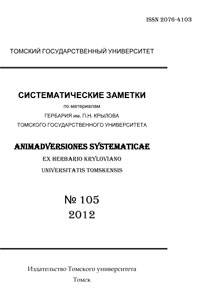Cousinia х pavlovii (Asteraceae), a new intersectional hybrid from Central Asia
Based on materials collected in the southern part of Syrdarya Karatau (Boraldai Mountains) and in the low mountains of Talas Alatau, as well as herbarium specimens kept in the Central Herbarium of Uzbekistan (TASH), a new interspecific and intersection hybrid Cousinia х pavlovii Kupr., Lashchinskiy et A.L. Ebel, nothosp. nov. is described. Parent species are Cousinia triflora Schrenk (section Oligantha Juz.) and C. umbrosa Bunge (section Pseudarctium Juz.) This nothospecies differs from the first parent species (C. triflora) by wider anthodia, phyllaries with a point bent at the top, and purple anthers. It differs from the second parent species (c. umbrosa) in usually sessile leathery stem leaves with a spike at the apex, narrower anthodia, phyllaries with narrow-walled bordering and stalked glands along the edge, pale yellow or fawn color of the corolla. It differs from C. triacantha Kult. in smaller, less-flowered floral heads, and the absence of spines along the edge of the phyllaries. Probable cause of hybridization is the transformation of valley communities as a result of overgrazing.
Keywords
Cousinia, Arctium, гибридизация, Средняя Азия, Cousinia, Arctium, hybridization, Middle AsiaAuthors
| Name | Organization | |
| Ebel A.L. | Tomsk State University | alex-08@mail2000.ru |
| Lashchinskiy N.N. | Central Siberian Botanical Garden of Siberian Branch of the Russian Academy of Sciences | nnl630090@gmail.com |
| Kupriyanov A.N. | The Federal Research Center of Coal and Coal Chemistry of Siberian Branch of the Russian Academy of Sciences | Kupr-42@yandex.ru |
| Khrustaleva I.A. | The Federal Research Center of Coal and Coal Chemistry of Siberian Branch of the Russian Academy of Sciences | Kupr-42@yandex.ru |
References

Cousinia х pavlovii (Asteraceae), a new intersectional hybrid from Central Asia | Sistematicheskie zametki po materialam Gerbariya im. P.N. Krylova Tomskogo gosudarstvennogo universiteta - Systematic notes on the materials of P.N. Krylov Herbarium of Tomsk State University. 2019. № 120. DOI: 10.17223/20764103.120.2